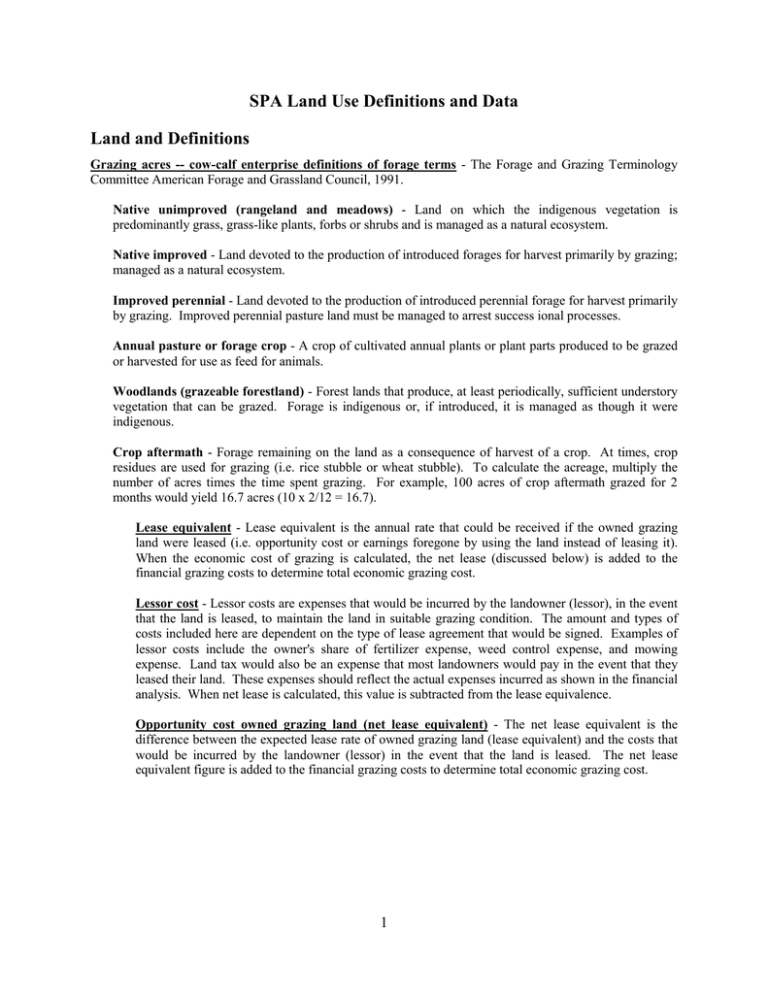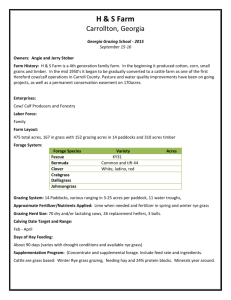SPA Land Use Definitions and Data Land and Definitions
advertisement

SPA Land Use Definitions and Data Land and Definitions Grazing acres -- cow-calf enterprise definitions of forage terms - The Forage and Grazing Terminology Committee American Forage and Grassland Council, 1991. Native unimproved (rangeland and meadows) - Land on which the indigenous vegetation is predominantly grass, grass-like plants, forbs or shrubs and is managed as a natural ecosystem. Native improved - Land devoted to the production of introduced forages for harvest primarily by grazing; managed as a natural ecosystem. Improved perennial - Land devoted to the production of introduced perennial forage for harvest primarily by grazing. Improved perennial pasture land must be managed to arrest success ional processes. Annual pasture or forage crop - A crop of cultivated annual plants or plant parts produced to be grazed or harvested for use as feed for animals. Woodlands (grazeable forestland) - Forest lands that produce, at least periodically, sufficient understory vegetation that can be grazed. Forage is indigenous or, if introduced, it is managed as though it were indigenous. Crop aftermath - Forage remaining on the land as a consequence of harvest of a crop. At times, crop residues are used for grazing (i.e. rice stubble or wheat stubble). To calculate the acreage, multiply the number of acres times the time spent grazing. For example, 100 acres of crop aftermath grazed for 2 months would yield 16.7 acres (10 x 2/12 = 16.7). Lease equivalent - Lease equivalent is the annual rate that could be received if the owned grazing land were leased (i.e. opportunity cost or earnings foregone by using the land instead of leasing it). When the economic cost of grazing is calculated, the net lease (discussed below) is added to the financial grazing costs to determine total economic grazing cost. Lessor cost - Lessor costs are expenses that would be incurred by the landowner (lessor), in the event that the land is leased, to maintain the land in suitable grazing condition. The amount and types of costs included here are dependent on the type of lease agreement that would be signed. Examples of lessor costs include the owner's share of fertilizer expense, weed control expense, and mowing expense. Land tax would also be an expense that most landowners would pay in the event that they leased their land. These expenses should reflect the actual expenses incurred as shown in the financial analysis. When net lease is calculated, this value is subtracted from the lease equivalence. Opportunity cost owned grazing land (net lease equivalent) - The net lease equivalent is the difference between the expected lease rate of owned grazing land (lease equivalent) and the costs that would be incurred by the landowner (lessor) in the event that the land is leased. The net lease equivalent figure is added to the financial grazing costs to determine total economic grazing cost. 1 Raised feed acres - Raised feed land acres, i.e. land for hay production, must be adjusted for the amount of production or raised feed actually used by the cow-calf enterprise. Consider for example, a situation where the raised feed land (hay pasture) totaled 85 acres and produced 25,000 pounds of hay. Of the total hay production 12,500 pounds of the hay is fed, 10,000 pounds sold and the balance, 2500 pounds, is in inventory. Therefore, 50% of the production [(12500/25000) x 100] was actually fed to the cow-calf enterprise and the acreage should be adjusted. Total raised feed acres times percentage of production fed (i.e. 85 x (12500/25000) = 42.5 ac.) equals adjusted raised feed land acreage. Silage fed should be converted to a dry air basis (i.e. 6000# of silage, 60% moisture content, 40% DM or 2400 lbs. DM converts to 2759 lbs. of 13% moisture content, 2400/.87). Leased land - The same descriptions and calculations are utilized for leased land as that used with owned land with the exception that the actual lease expense is not recorded as they are in the financial data. Land for Grazing and Raised Feed Land used for the cow-calf enterprise should be summarized in the following forms. Remember to divide land into owned land, grazing and raised feed, and leased land, grazing and raised feed. Read the definitions carefully before filling out the forms. 2






